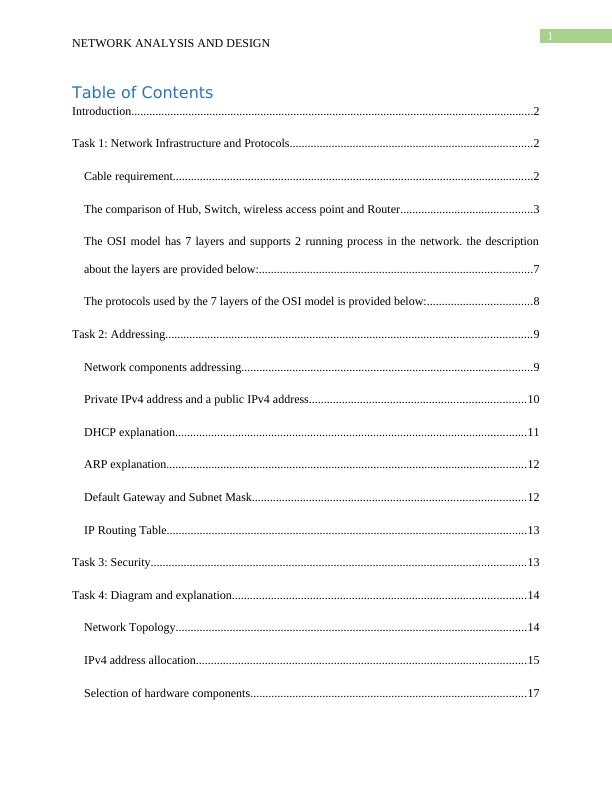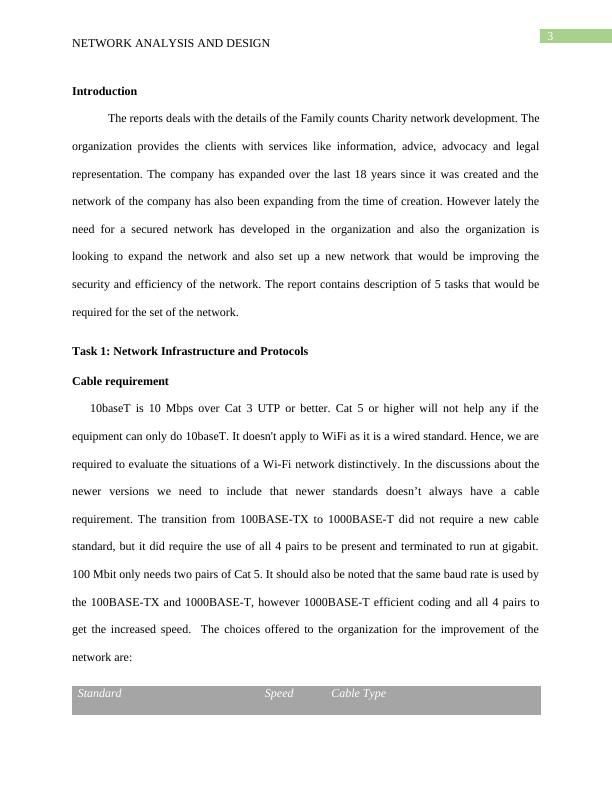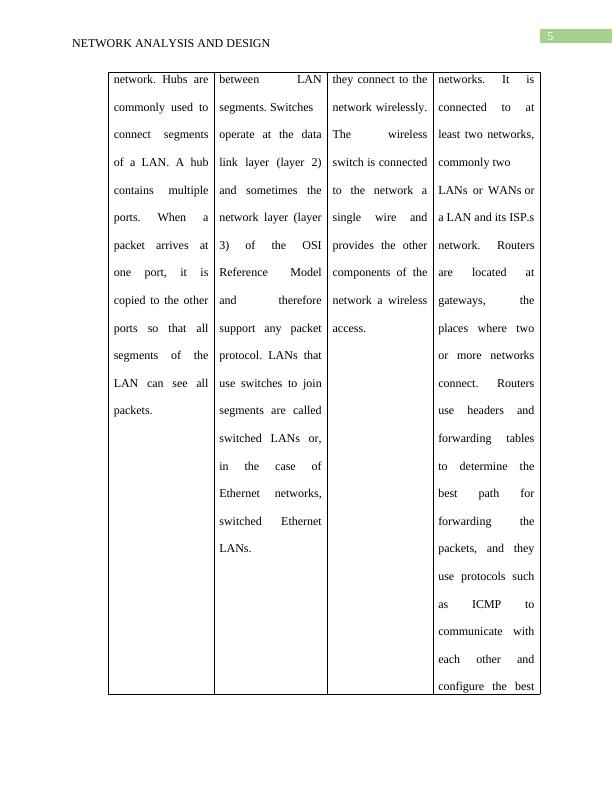Network Analysis and Design for Desklib Online Library
Added on 2023-06-12
29 Pages5615 Words385 Views
Running head: NETWORK ANALYSIS AND DESIGN
Network Analysis and Design
Name of Student:
Name of the University:
Author Note
Network Analysis and Design
Name of Student:
Name of the University:
Author Note

1
NETWORK ANALYSIS AND DESIGN
Table of Contents
Introduction......................................................................................................................................2
Task 1: Network Infrastructure and Protocols.................................................................................2
Cable requirement........................................................................................................................2
The comparison of Hub, Switch, wireless access point and Router............................................3
The OSI model has 7 layers and supports 2 running process in the network. the description
about the layers are provided below:...........................................................................................7
The protocols used by the 7 layers of the OSI model is provided below:...................................8
Task 2: Addressing..........................................................................................................................9
Network components addressing.................................................................................................9
Private IPv4 address and a public IPv4 address........................................................................10
DHCP explanation.....................................................................................................................11
ARP explanation........................................................................................................................12
Default Gateway and Subnet Mask...........................................................................................12
IP Routing Table........................................................................................................................13
Task 3: Security.............................................................................................................................13
Task 4: Diagram and explanation..................................................................................................14
Network Topology.....................................................................................................................14
IPv4 address allocation..............................................................................................................15
Selection of hardware components............................................................................................17
NETWORK ANALYSIS AND DESIGN
Table of Contents
Introduction......................................................................................................................................2
Task 1: Network Infrastructure and Protocols.................................................................................2
Cable requirement........................................................................................................................2
The comparison of Hub, Switch, wireless access point and Router............................................3
The OSI model has 7 layers and supports 2 running process in the network. the description
about the layers are provided below:...........................................................................................7
The protocols used by the 7 layers of the OSI model is provided below:...................................8
Task 2: Addressing..........................................................................................................................9
Network components addressing.................................................................................................9
Private IPv4 address and a public IPv4 address........................................................................10
DHCP explanation.....................................................................................................................11
ARP explanation........................................................................................................................12
Default Gateway and Subnet Mask...........................................................................................12
IP Routing Table........................................................................................................................13
Task 3: Security.............................................................................................................................13
Task 4: Diagram and explanation..................................................................................................14
Network Topology.....................................................................................................................14
IPv4 address allocation..............................................................................................................15
Selection of hardware components............................................................................................17

2
NETWORK ANALYSIS AND DESIGN
Prices of the recommended hardware........................................................................................17
Task 5: Remote access...................................................................................................................22
Remote access security..............................................................................................................22
Dropbox justification.................................................................................................................22
Impact of remote access on the system......................................................................................23
Bibliography..................................................................................................................................24
NETWORK ANALYSIS AND DESIGN
Prices of the recommended hardware........................................................................................17
Task 5: Remote access...................................................................................................................22
Remote access security..............................................................................................................22
Dropbox justification.................................................................................................................22
Impact of remote access on the system......................................................................................23
Bibliography..................................................................................................................................24

3
NETWORK ANALYSIS AND DESIGN
Introduction
The reports deals with the details of the Family counts Charity network development. The
organization provides the clients with services like information, advice, advocacy and legal
representation. The company has expanded over the last 18 years since it was created and the
network of the company has also been expanding from the time of creation. However lately the
need for a secured network has developed in the organization and also the organization is
looking to expand the network and also set up a new network that would be improving the
security and efficiency of the network. The report contains description of 5 tasks that would be
required for the set of the network.
Task 1: Network Infrastructure and Protocols
Cable requirement
10baseT is 10 Mbps over Cat 3 UTP or better. Cat 5 or higher will not help any if the
equipment can only do 10baseT. It doesn't apply to WiFi as it is a wired standard. Hence, we are
required to evaluate the situations of a Wi-Fi network distinctively. In the discussions about the
newer versions we need to include that newer standards doesn’t always have a cable
requirement. The transition from 100BASE-TX to 1000BASE-T did not require a new cable
standard, but it did require the use of all 4 pairs to be present and terminated to run at gigabit.
100 Mbit only needs two pairs of Cat 5. It should also be noted that the same baud rate is used by
the 100BASE-TX and 1000BASE-T, however 1000BASE-T efficient coding and all 4 pairs to
get the increased speed. The choices offered to the organization for the improvement of the
network are:
Standard Speed Cable Type
NETWORK ANALYSIS AND DESIGN
Introduction
The reports deals with the details of the Family counts Charity network development. The
organization provides the clients with services like information, advice, advocacy and legal
representation. The company has expanded over the last 18 years since it was created and the
network of the company has also been expanding from the time of creation. However lately the
need for a secured network has developed in the organization and also the organization is
looking to expand the network and also set up a new network that would be improving the
security and efficiency of the network. The report contains description of 5 tasks that would be
required for the set of the network.
Task 1: Network Infrastructure and Protocols
Cable requirement
10baseT is 10 Mbps over Cat 3 UTP or better. Cat 5 or higher will not help any if the
equipment can only do 10baseT. It doesn't apply to WiFi as it is a wired standard. Hence, we are
required to evaluate the situations of a Wi-Fi network distinctively. In the discussions about the
newer versions we need to include that newer standards doesn’t always have a cable
requirement. The transition from 100BASE-TX to 1000BASE-T did not require a new cable
standard, but it did require the use of all 4 pairs to be present and terminated to run at gigabit.
100 Mbit only needs two pairs of Cat 5. It should also be noted that the same baud rate is used by
the 100BASE-TX and 1000BASE-T, however 1000BASE-T efficient coding and all 4 pairs to
get the increased speed. The choices offered to the organization for the improvement of the
network are:
Standard Speed Cable Type

4
NETWORK ANALYSIS AND DESIGN
10Base-T 10 Mbps Cat 5
100Base-TX (Fast Ethernet) 100 Mbps Cat 5e
1000Base-T (Gigabit Ethernet) 1 Gbps Cat 5e or better (Cat 6, 6A...)
10GBase-T (10 Gigabit Ethernet) 10 Gbps Cat 6A, or Cat 6 (limited to 55 meters)
In addition to the above mentioned options the options regarding the wireless network is
described below. Typically an organization should try to implement a network that is mostly
wired. In addition to the wired network the wireless access points to the network should be added
according to the requirement of the organization. There are various choice open to the
organization for the setup of the wireless network access in the network. There are different
frequencies used (2.4 or 5 GHz typically), which standard of 802.11 (examples include 802.11n
or 802.11ac). The 10Base-T part stands out to me as a sort of "diversion". It should be noted that
the newer versions of Ethernet will work with older devices, so a 10Base-T device will work just
fine on a network that supports Gigabit speeds; however, that link will be limited to 10 Mbps. On
another note, Cat 5 (not 5e) cable is basically obsolete. Cat 5e is still very common, hence it is
recommended that the Cat 6 or the Cat 6A cables are used for the network and this would
provide the network with a scope to accommodate future use of 10 Gigabit Ethernet, and
applications using Power over Ethernet to provide power to Wi-Fi access points.
The comparison of Hub, Switch, wireless access point and Router
HUB SWITCH WIRELESS
ACCES POINT
ROUTER
A common
connection point
for devices in a
In networks, a
device that filters
and forwards packets
The wireless access
points are similar
to the switches
This device
forwards data
packets along
NETWORK ANALYSIS AND DESIGN
10Base-T 10 Mbps Cat 5
100Base-TX (Fast Ethernet) 100 Mbps Cat 5e
1000Base-T (Gigabit Ethernet) 1 Gbps Cat 5e or better (Cat 6, 6A...)
10GBase-T (10 Gigabit Ethernet) 10 Gbps Cat 6A, or Cat 6 (limited to 55 meters)
In addition to the above mentioned options the options regarding the wireless network is
described below. Typically an organization should try to implement a network that is mostly
wired. In addition to the wired network the wireless access points to the network should be added
according to the requirement of the organization. There are various choice open to the
organization for the setup of the wireless network access in the network. There are different
frequencies used (2.4 or 5 GHz typically), which standard of 802.11 (examples include 802.11n
or 802.11ac). The 10Base-T part stands out to me as a sort of "diversion". It should be noted that
the newer versions of Ethernet will work with older devices, so a 10Base-T device will work just
fine on a network that supports Gigabit speeds; however, that link will be limited to 10 Mbps. On
another note, Cat 5 (not 5e) cable is basically obsolete. Cat 5e is still very common, hence it is
recommended that the Cat 6 or the Cat 6A cables are used for the network and this would
provide the network with a scope to accommodate future use of 10 Gigabit Ethernet, and
applications using Power over Ethernet to provide power to Wi-Fi access points.
The comparison of Hub, Switch, wireless access point and Router
HUB SWITCH WIRELESS
ACCES POINT
ROUTER
A common
connection point
for devices in a
In networks, a
device that filters
and forwards packets
The wireless access
points are similar
to the switches
This device
forwards data
packets along

5
NETWORK ANALYSIS AND DESIGN
network. Hubs are
commonly used to
connect segments
of a LAN. A hub
contains multiple
ports. When a
packet arrives at
one port, it is
copied to the other
ports so that all
segments of the
LAN can see all
packets.
between LAN
segments. Switches
operate at the data
link layer (layer 2)
and sometimes the
network layer (layer
3) of the OSI
Reference Model
and therefore
support any packet
protocol. LANs that
use switches to join
segments are called
switched LANs or,
in the case of
Ethernet networks,
switched Ethernet
LANs.
they connect to the
network wirelessly.
The wireless
switch is connected
to the network a
single wire and
provides the other
components of the
network a wireless
access.
networks. It is
connected to at
least two networks,
commonly two
LANs or WANs or
a LAN and its ISP.s
network. Routers
are located at
gateways, the
places where two
or more networks
connect. Routers
use headers and
forwarding tables
to determine the
best path for
forwarding the
packets, and they
use protocols such
as ICMP to
communicate with
each other and
configure the best
NETWORK ANALYSIS AND DESIGN
network. Hubs are
commonly used to
connect segments
of a LAN. A hub
contains multiple
ports. When a
packet arrives at
one port, it is
copied to the other
ports so that all
segments of the
LAN can see all
packets.
between LAN
segments. Switches
operate at the data
link layer (layer 2)
and sometimes the
network layer (layer
3) of the OSI
Reference Model
and therefore
support any packet
protocol. LANs that
use switches to join
segments are called
switched LANs or,
in the case of
Ethernet networks,
switched Ethernet
LANs.
they connect to the
network wirelessly.
The wireless
switch is connected
to the network a
single wire and
provides the other
components of the
network a wireless
access.
networks. It is
connected to at
least two networks,
commonly two
LANs or WANs or
a LAN and its ISP.s
network. Routers
are located at
gateways, the
places where two
or more networks
connect. Routers
use headers and
forwarding tables
to determine the
best path for
forwarding the
packets, and they
use protocols such
as ICMP to
communicate with
each other and
configure the best

End of preview
Want to access all the pages? Upload your documents or become a member.
Related Documents
Networking Guide for College Studentslg...
|16
|657
|166
Computer Networks for Perfect Home Lettings Agencylg...
|18
|4952
|346
Telecommunication and Network Securitylg...
|8
|1203
|486
Applied Communication: Solutions for IPv6, Network Cables, OSI and TCP/IP Modelslg...
|6
|1090
|80
IT Networking Designinglg...
|9
|845
|84
ISY202 Information System Assignment | Networking Assignmentlg...
|13
|2071
|71
